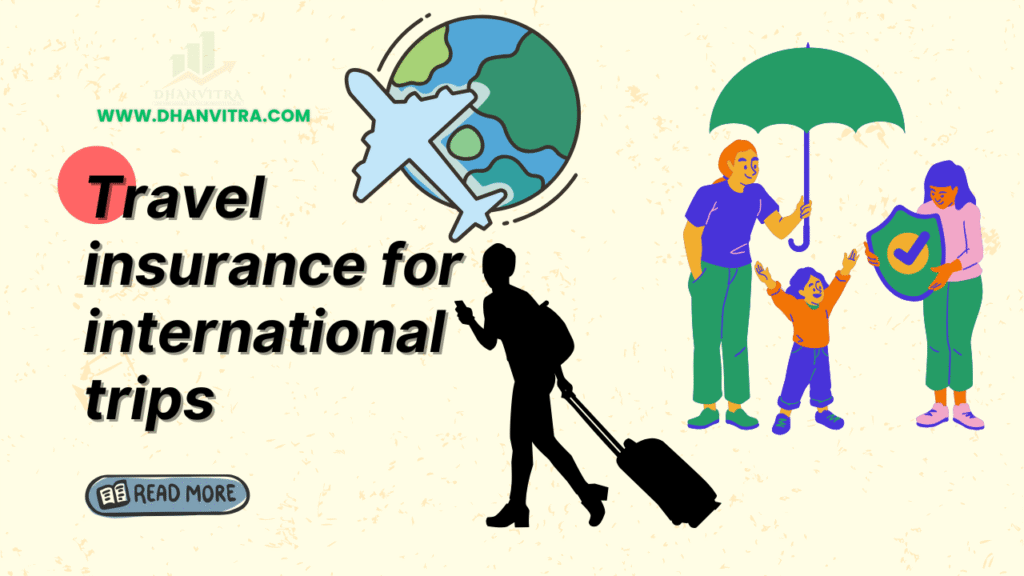
Traveling abroad is an exciting adventure—whether it’s exploring the bustling streets of Tokyo, relaxing on Bali’s beaches, or discovering historical gems in Europe. However, one important factor is frequently disregarded while arranging your trip, flights, and lodging: trip insurance. At Dhanvitra, we understand that international trips come with unique risks—medical emergencies, flight cancellations, lost luggage, or unexpected delays can quickly turn your dream vacation into a stressful ordeal.
This guide will walk you through everything you need to know about the best travel insurance for international trips, helping you make informed decisions to protect yourself and your loved ones while traveling. From understanding different types of coverage to selecting the right policy tailored to your needs, we’ll cover it all in simple, practical terms, so you can travel with confidence and peace of mind.
What is Travel Insurance?
Travel insurance is, in essence, a safety net for tourists. Think of it as a financial shield that protects you from unexpected mishaps while you explore the world. It’s more than just a policy—it’s peace of mind.
Travel insurance typically covers:
- Medical Emergencies: Whether you fall sick or get injured, travel insurance ensures you’re not paying huge hospital bills in a foreign country.
- Trip Cancellations or Interruptions: Flights get delayed, natural disasters strike, or emergencies occur. Insurance helps recover non-refundable expenses.
- Missing or Stolen Items: Travel insurance can pay you for anything that has been lost or stolen, from gadgets to baggage.
- Personal Liability: Some plans even cover damages caused accidentally to others during your travels.
Globally, travel insurance varies depending on the provider, but the core purpose remains universal: to safeguard your journey and finances against unpredictable events.
Why You Need Travel Insurance for International Trips
Traveling abroad is exciting, but it comes with risks you might not encounter at home. Here’s why travel insurance is a must for international trips:
- Medical Emergencies Abroad
Hospitals in foreign countries can be expensive. Even routine care can cost hundreds of dollars, and serious emergencies can reach tens of thousands. Travel insurance ensures that your treatment is covered and helps you avoid financial strain. - Trip Cancellations or Interruptions
Imagine booking a dream vacation and suddenly needing to cancel due to illness, a family emergency, or a natural disaster. Travel insurance can reimburse non-refundable costs. - Lost, Stolen, or Delayed Belongings
From luggage going missing to electronics being stolen, these incidents are more common than travelers think. Travel insurance often covers the replacement of essential items and sometimes compensates for delayed luggage. - Peace of Mind
Traveling internationally can be stressful without a backup plan. Insurance provides security, letting you focus on enjoying your trip rather than worrying about “what if” scenarios. - Coverage for Adventure Activities
Planning to go skiing in the Alps, scuba diving in the Caribbean, or trekking in Nepal? Standard health insurance often excludes adventure sports, but travel insurance can fill that gap.
Types of Travel Insurance Plans
Travel insurance isn’t one-size-fits-all. Depending on your travel style and frequency, you can choose from different plans:
Single-Trip Insurance
Perfect for infrequent travelers, this option includes coverage for a single journey. It is budget-friendly for a brief holiday or work trip overseas.
Annual/Multi-Trip Insurance
Ideal for travelers, this plan includes various journeys throughout the year. It is more convenient and frequently less expensive than purchasing individual single-trip plans.
Backpacker Insurance
Designed for long-term travelers, students, or digital nomads exploring multiple countries. It covers longer durations and often includes adventure sports.
Family Travel Insurance
Covers all family members under one policy. It’s especially useful for families traveling internationally, often at a lower combined cost than individual policies.
Key Features to Look For
When choosing travel insurance, focus on these essential features to ensure you’re fully protected:
- Medical Coverage
Look for comprehensive medical coverage that includes hospitalization, emergency treatment, doctor visits, and even dental emergencies abroad. - Emergency Evacuation
In case of a severe illness or natural disaster, evacuation to the nearest medical facility or even back home can be expensive. Ensure your policy covers emergency transportation. - Trip Cancellation/Interruption
Coverage for non-refundable flight tickets, hotel bookings, and tour packages if unforeseen events force you to cancel or shorten your trip. - Baggage Loss and Delay
Compensation for lost, stolen, or delayed luggage, ensuring you’re not left stranded without essentials. - Adventure Sports Coverage
If you plan to engage in activities like skiing, scuba diving, or trekking, make sure your policy explicitly covers adventure sports, which standard plans often exclude. - 24/7 Assistance Services
Look for providers that offer round-the-clock support, helping you navigate emergencies, hospital referrals, and claims anywhere in the world.
Table of Contents
Top Providers of International Travel Insurance
Here’s a deeper look at some leading providers, including coverage amounts and unique offerings:
| Provider | Medical Coverage | Trip Cancellation | Adventure Sports | 24/7 Support | Ideal For |
|---|---|---|---|---|---|
| Allianz Global Assistance | Up to $1,000,000 | Up to the trip cost | Optional add-on | Yes | Families, seniors, business travelers |
| AXA Assistance | Up to $500,000 | Up to the trip cost | Optional | Yes | Short-term travelers, flexible plans |
| World Nomads | Up to $100,000 | Up to $10,000 | Includes many adventure activities | Yes | Backpackers, adventure travelers |
| Travel Guard (AIG) | Up to $1,000,000 | Up to trip cost | Optional add-on | Yes | Long international trips, comprehensive plans |
| InsureMyTrip | Varies by provider | Varies | Varies | Yes | Travelers comparing multiple options |
Case Study Example:
Imagine Emma, a 32-year-old solo traveler from Australia, planning a 3-week trek in Nepal. She chooses World Nomads because it includes trekking coverage and medical evacuation. During the trek, she sprains her ankle and requires a helicopter evacuation costing $6,500. Her insurance fully covers this, saving her from a major financial setback.
How to Choose the Best Travel Insurance
1. Assess Your Travel Needs
If your trip involves skiing in Switzerland, choose a plan that explicitly covers winter sports. For a medical-heavy trip to the USA, prioritize high medical coverage.
2. Compare Coverage and Limits
Example:
- Allianz Global Assistance: $1,000,000 medical coverage
- World Nomads: $100,000 medical coverage
If your trip involves high-cost healthcare countries, Allianz might be a better fit despite being more expensive.
3. Read the Fine Print
- Certain insurance providers do not cover injuries resulting from extreme sports unless you purchase an additional policy.
- Many policies won’t cover epidemics unless specifically stated.
4. Check for Pre-existing Conditions
Example:
- John has diabetes and wants to travel to Europe. He chooses AXA Assistance, which offers coverage for declared pre-existing conditions after a medical questionnaire.
Cost of Travel Insurance
Factors affecting cost:
- Age: Travelers over 60 pay 50-100% more.
- Trip duration: A 2-week trip might cost $150-$250 for a single traveler.
- Destination: U.S. trips are generally pricier due to high healthcare costs.
Example Scenarios:
- Short trip to Thailand (10 days) – Coverage $50,000 medical, $5,000 trip cancellation = ~$75-$120
- Long Europe trip (3 weeks) – Coverage $500,000 medical, $10,000 trip cancellation = ~$250-$350
- Family of four traveling to the USA for two weeks – Insurance coverage of $1,000,000 for medical expenses costs approximately $600 to $700.
Advice: Always obtain insurance immediately after making a reservation to ensure better cancellation protection.
Common Mistakes Travelers Make
1. Underinsuring Themselves
- Example: Alex bought a basic plan with $50,000 medical coverage. A hospital visit in the U.S. costs $75,000. Result: out-of-pocket expenses $25,000.
2. Ignoring Adventure or Sports Coverage
- Example: Sarah went scuba diving in Bali. Her standard insurance didn’t cover it. A claim was denied.
3. Failing to Declare Pre-existing Conditions
- Example: Tom had a heart problem, but did not mention it. He required urgent treatment in Spain, and his claim was turned down.
4. Waiting Until the Last Minute
- Last-minute purchase often excludes coverage for pre-existing conditions or early trip cancellations.
Tips for Filing a Travel Insurance Claim
Step-by-step example:
- Document everything: Flight delays? Keep boarding passes. Lost luggage? Take photos.
- Contact the provider immediately: Allianz’s 24/7 hotline is available worldwide.
- Keep receipts: Medical bills, hotel receipts, or emergency transport invoices.
- Follow procedures: Submit claims online or via app. Track progress using your insurer’s mobile platform.
Case Study:
During a 2-week trip to Canada, Maria fell sick and needed hospitalization. She contacted AXA Assistance, submitted hospital bills via the app, and received reimbursement of $7,200 within 10 days.
Travel Insurance for Special Groups
1. Seniors
- Coverage example: Allianz offers $1,000,000 medical coverage for travelers aged 65+, with optional pre-existing condition coverage.
2. Students and Young Travelers
- Coverage example: World Nomads offers $100,000 medical coverage and adventure activity inclusion, ideal for backpacking or gap year travel.
3. Business Travelers
- Example: Travel Guard provides coverage for lost work equipment, business trip cancellations, and emergency medical care.
4. Families with Children
- Example: AXA family plan covers up to 5 members under a single policy, including medical, trip interruption, and baggage coverage.
Travel Insurance Myths Debunked
When it comes to travel insurance, many misconceptions can prevent travelers from getting the coverage they need.
Myth 1: “I’m healthy, I don’t need it.”
Being healthy doesn’t guarantee that nothing will go wrong abroad. Accidents, theft, lost luggage, or sudden illnesses can affect anyone. Travel insurance protects you from financial setbacks caused by events outside your control.
Myth 2: “Credit cards cover everything.”
While some premium credit cards offer partial coverage for trips booked using the card, they often fall short. Limitations may include low coverage amounts, no coverage for pre-existing conditions, or exclusions for adventure activities.
Myth 3: “It’s too expensive.”
Travel insurance is surprisingly affordable, especially when weighed against potential medical bills or the cost of replacing lost items abroad. Many policies start at just a few dollars per day, making it a smart investment for peace of mind.
Myth 4: “It only covers medical emergencies.”
Most travel insurance plans also cover trip cancellations, lost baggage, delays, and even emergencies like evacuation due to natural disasters or political unrest. It’s a multi-layered safety net for travelers.
Myth 5: “I can buy it anytime.”
While you can purchase coverage close to your departure, buying early often provides additional benefits, like coverage for pre-existing conditions or trip cancellations. Waiting until the last minute can limit your options.
By understanding these myths, global travelers can make informed choices, ensuring they’re fully protected wherever they go.
How Technology Helps Travelers with Insurance
Technology has transformed the way travelers manage insurance, making it easier, faster, and more reliable. Here’s how:
Mobile Apps for Claims
Many insurance providers now offer mobile apps where you can submit claims directly from your phone. Snap a photo of receipts, upload documents, and track your claim status in real-time, eliminating tedious paperwork.
Online Policy Management
You can now buy, renew, and customize your policy online. This allows travelers to adjust coverage based on trip length, destination, or activities, without visiting an office.
Instant Travel Alerts
Insurance apps and websites provide alerts about travel disruptions, epidemics, natural disasters, or political unrest in your destination country. This proactive approach helps travelers stay safe and adjust plans if needed.
24/7 Emergency Support
Tech-enabled insurance provides round-the-clock access to assistance services. Whether you need to find a local hospital, arrange emergency transport, or contact customer support, help is just a few taps away.
Digital Travel Insurance Cards
No need to carry paper policies anymore. Digital cards on your smartphone provide proof of insurance, which is often required at hospitals or border checks.
By leveraging technology, travelers worldwide can enjoy smoother, safer journeys with minimal stress.
Conclusion
From medical emergencies and trip cancellations to lost luggage and adventure activities, the right policy covers it all. Don’t let myths or misconceptions hold you back—invest in coverage that suits your travel style and needs. In a globalized world where international travel is common, being insured is smart, practical, and essential.
Remember, technology makes insurance easier than ever, allowing instant claims, mobile alerts, and 24/7 support. By understanding your options and leveraging modern tools, you can explore the world confidently, knowing you’re protected no matter where you go.
FAQs
What is the best travel insurance for short trips abroad?
Single-trip policies are ideal for short trips. Look for comprehensive coverage, including medical emergencies, trip cancellations, and baggage protection.
Can I buy travel insurance after booking a trip?
Yes, but it’s recommended to buy it as soon as possible. Early purchase often includes benefits like coverage for pre-existing conditions and trip cancellations.
Does travel insurance cover extreme sports?
Certain insurance plans provide extra protection for adventurous activities such as skiing, scuba diving, or hiking. Always review the policy information before your trip.
Is pre-existing medical condition coverage available?
Several insurance companies offer protection for health issues that existed before getting the policy, as long as you mention them when buying. The rules and qualifications can be different, so it is important to check the details closely.
How do I claim while abroad?
Document the incident, keep receipts, and contact your insurance provider immediately. Many providers allow claims submission via mobile apps or online portals for faster processing.






Traveling abroad soon? Don’t forget to look into travel insurance! I’ve heard great things about a few companies that offer solid coverage for international adventures. Can’t wait to hear your favorites! 😊
Just booked my first international trip and I’m diving into travel insurance options! Any recommendations for the best coverage? I want to make sure I’m fully protected while exploring new places! 🌍✈️
Hey fellow travelers! As I plan my next international getaway, I’m curious—what’s your go-to travel insurance? It’s so important to have peace of mind while exploring the world! 🗺️
International trips are so exciting, but they can come with risks too! What’s everyone’s favorite travel insurance provider? I’d love some tips before I finalize my plans! 🌏❤️
Planning an overseas adventure? Make sure you’ve got the right travel insurance! I’m on the hunt for the best options out there—let’s share our top picks! ✈️🌟